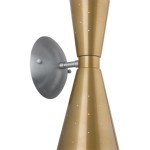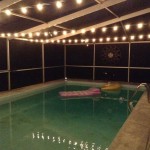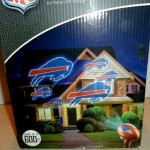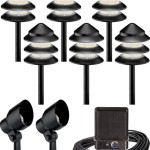Can You Use An Outdoor Projector During the Day?
The allure of outdoor entertainment has significantly increased in recent years. Imagine enjoying movies, sports, or video games on a large screen under the open sky. Projectors offer an accessible and scalable solution for this, but a common question arises: Can projectors truly be used outdoors during the daytime? The answer is not a simple yes or no, as multiple factors influence the visibility and overall experience of projecting an image outdoors in daylight.
The primary challenge rests with ambient light. Sunlight is incredibly powerful, and even on overcast days, the level of ambient light significantly impacts the perceived brightness of a projected image. Projectors work by shining light onto a surface, and the brighter the ambient light, the more difficult it is for the projected light to compete and create a visible image. Therefore, successful daytime outdoor projection requires careful consideration of several key aspects, including projector brightness, screen selection, ambient light control, and projector technology.
Projector Brightness: The Lumen Factor
Projector brightness is measured in lumens. A lumen represents the amount of light emitted by the projector. The higher the lumen rating, the brighter the image the projector can produce. For indoor use, a projector with 1,500 to 2,000 lumens might suffice in a darkened room. However, outdoor daytime projection demands significantly more.
Generally, a projector with at least 3,000 lumens is considered the bare minimum for attempting daytime outdoor projection. However, even at this level, the image quality will likely be compromised and best suited for cloudy conditions or shaded areas. For brighter environments, such as direct sunlight, a projector with 5,000 lumens or more is highly recommended. This increased brightness allows the projector to compete more effectively against the sun's intensity, resulting in a more visible and enjoyable image.
It is important to note that lumen ratings provided by manufacturers are sometimes optimistic. Reading reviews and comparing specifications across different models is crucial to ensure you are selecting a projector that genuinely delivers the promised brightness. Furthermore, brightness can decrease over time as the projector lamp ages, so factoring in lamp life and potential replacement costs is a prudent consideration.
Beyond the initial lumen rating, understanding the projector’s contrast ratio is also vital. Contrast ratio refers to the difference between the darkest and brightest parts of an image. A higher contrast ratio contributes to a more vibrant and defined image, making it easier to see details even in brighter environments. Look for projectors with a contrast ratio of at least 2,000:1 for better outdoor performance.
Screen Selection: Optimizing Reflection and Minimizing Ambient Light
The projection screen plays a critical role in the overall success of daytime outdoor projection. A standard white screen, commonly used indoors, can be inadequate for outdoor use due to its tendency to reflect ambient light, washing out the projected image. Therefore, selecting a screen specifically designed for outdoor use is highly recommended.
Specialized outdoor projection screens are often coated with materials that enhance brightness and contrast while minimizing the effects of ambient light. These screens may feature a gray or silver tint, which helps to absorb ambient light and improve the black levels of the projected image. Some screens also incorporate gain, which refers to the screen’s ability to focus reflected light back towards the viewer. A higher gain screen can make the image appear brighter, but it also tends to narrow the viewing angle.
Another type of screen suitable for daytime use is an ambient light rejecting (ALR) screen. ALR screens are designed to reject light coming from above or the sides, directing only the light from the projector towards the viewer. This technology dramatically improves the image quality in bright environments, allowing for a more enjoyable viewing experience even during the day.
When choosing a screen, consider its size and viewing angle. A larger screen provides a more immersive experience, but it also requires a brighter projector to adequately illuminate the entire surface. The viewing angle determines how far off-axis viewers can sit and still see a clear image. For larger gatherings, a screen with a wider viewing angle is preferable.
Beyond specialized materials, the placement of the screen is also important. Ideally, the screen should be positioned in a shaded area, away from direct sunlight. Using natural features like trees or buildings to create shade can significantly improve the image quality. If shade is not available, consider using tarps or awnings to block out the sun.
Environmental Considerations and Additional Factors
Even with a bright projector and a specialized screen, ambient light control remains crucial for optimal daytime outdoor projection. The amount of ambient light will vary throughout the day, depending on the time, weather conditions, and surrounding environment. Pay attention to the position of the sun and how it affects the viewing area.
Beyond sunlight, other sources of ambient light, such as streetlights or lights from neighboring houses, can also impact the projected image. Consider these factors when choosing a location for your outdoor theater. If possible, try to minimize the amount of ambient light entering the viewing area. This might involve using curtains or blinds to block out unwanted light, or simply waiting until later in the evening when the ambient light is lower.
Projector technology also plays a role. LCD projectors tend to produce brighter images than DLP projectors, making them a better choice for daytime use. However, DLP projectors often offer better contrast ratios and color accuracy. LED projectors are becoming increasingly popular due to their long lamp life and energy efficiency, but they may not be as bright as LCD or DLP projectors. Laser projectors are the brightest option currently available, making them ideal for daytime outdoor projection, but they are also the most expensive.
The color of surrounding objects can also affect the perceived brightness of the projected image. Darker surfaces absorb more light, while lighter surfaces reflect more light. If the area surrounding the screen is brightly colored, it may reflect ambient light onto the screen, washing out the image. Using darker colors in the surrounding area can help to improve contrast.
Finally, consider the audio experience. Outdoor environments are often noisy, so using a powerful sound system is essential to ensure that everyone can hear the audio clearly. Wireless speakers can be a convenient option for outdoor use, allowing you to place the speakers where they are needed without having to run cables. Subwoofers can also enhance the audio experience, providing deeper bass and more immersive sound.
Ultimately, achieving a satisfactory outdoor projection experience during the day requires a combination of the right equipment, careful planning, and a willingness to adapt to the specific environmental conditions. By paying attention to projector brightness, screen selection, ambient light control, and other key factors, it is possible to create a enjoyable outdoor viewing experience, even under the sun.

Looking For An Outdoor Daytime Projector Benq Au

Can You Use A Projector During The Day

How To Use A Projector Outside During The Day

Using A Projector Outside During The Day Home Theater Diy
Which Projector Should I Use In Outdoor Daylight Quora

How To Use A Projector Outside During The Day 8 Things Consider

How To Use Projector During The Day Quick Guide 2024

How To Use A Projector Outside During The Day Ninja

Do Projectors Work During The Day In November 4 2024

Using A Projector Outside During The Day Home Theater Diy
Related Posts







